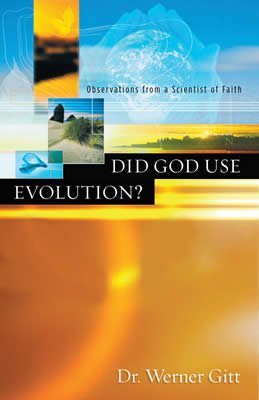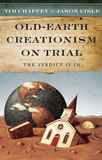
1.3 The Basic Assumptions of Creationism
Theories and models of the various creation disciplines are based on the following presuppositions, each of which is diametrically opposed to evolutionary assumptions.
Theories and models of the various creation disciplines are based on the following presuppositions. Assumptions E1 and C1, E2 and C2 . . . E12 and C12 deal with the same topics; their contents, however, are diametrically opposed. The basic assumptions clearly show that these two sets of principles are incompatible.
C1: The basic principle of creation is taken for granted. An understanding of the original creation can only be obtained through a biblical “temper of mind.” Biblical revelations are the key for understanding this world. The Bible is the basic, irreplaceable source of information. It is a fact of creation that we may not extrapolate the currently valid natural laws into the six days of creation. Our present experiences do not allow us to really evaluate something that has just been created.
Examples: All adults were children. But Adam could not have been created as a baby; he was a grown man. He never was a child, and it does not make sense to extrapolate a number of years into his life, just because our present experiences require that every adult should have been a child. Similarly, all the stars were immediately visible in spite of immense distances. Trees were not made as seedlings; they were fully grown and complete. Neither did the birds first have to hatch from their eggs and eventually grow up. The old question of “Which was first—the hen or the egg?” has a clear and unambiguous biblical answer.
C2: Creation is a universal principle, that is, the entire universe and all
life on earth originated at creation. According to John 1:1–3, creation
encompasses everything from the microcosm to the macrocosm and
from inanimate matter to man: “In the beginning was the Word,
and the Word was with God, and the Word was God. . . . All things
were made by him; and without him was not any thing made that
was made
” (KJV).
C3: The Creator exists. He is the God of the Bible. The Bible begins with the affirmation “In the beginning God created the heaven and the earth,” and this is clearly an important basic assumption as defined by us. God is not there to fill the as yet unexplainable gaps in natural phenomena, but He is the Primal Cause of ALL things, whether or not we already understand them scientifically. If we should relegate to the Creator only those matters which are not (yet) explainable, then everything which has already been explained, may be used to “prove” the non-existence of God. Then, as scientific knowledge accumulates, God is increasingly “explained away” (see chapter 8.6).
C4: The matter of the entire universe has been created without the use
of previously existing matter. This basic principle is formulated in Hebrews 11:3: “By faith we understand that the universe was formed
at God’s command, so that what is seen was not made out of what
was visible.
”
C5: There is a fundamental difference between the creation of the world and all living organisms on the one hand, and the subsequent processes. Natural laws derive from our experiences with matter which consistently repeat themselves; the present creation functions according to these laws in every detail. They were established at creation and provide the limits within which expected outcomes are guaranteed and can even be calculated beforehand (e.g., the law of gravity, and the laws governing chemical reactions). These limits demarcate both possible events as in technological achievements, as well as impossible events (e.g., stones falling upward, and “perpetual motion” machines functioning without energy being supplied). The physical processes within living organisms are also subject to these limits.
C6: God’s creative activities cannot be explained in terms of natural laws, neither are they subject to the above limits. Creation is a singular event by which the present natural laws came into existence. Concerning these creative acts, one can only look so far across this “event horizon” as God reveals in His Word. That which God has revealed in Holy Scripture is therefore fundamental and irrefutable information which cannot be obtained otherwise.
Comment: According to the well-known law of the conservation of energy, energy cannot be created nor can it be destroyed in this universe. This fact illuminates basic assumption C6. The origin of the energy presently in the universe cannot be described in terms of known physical laws, because creation occurred outside the currently valid laws. Evolutionary presupposition E6 is contradicted by C6.
Analogy: The origin of the Bible can be seen as analogous to the creation of the universe. If creation cannot be explained in terms of natural laws, neither can the origin of God’s Word be explained by scientific methods like history, text criticisms, or archaeology. According to Isaiah 55:8–9, the acts of God concerning the establishment of the Bible is outside our field of understanding, therefore we can only understand it as far as it is revealed in God’s Word.
C7: The following factors or causes of creation are mentioned many times in the Bible:
- by the Word of God: Psalm 33:6; John 1:1–4; Hebrews 11:3
- by the power of God: Jeremiah 10:12
- by God’s wisdom: Psalm 104:24; Proverbs 3:19; Colossians 2:3
- according to the will of God: Genesis 1:26; Revelation 4:11
- by the Son of God: John 1:1–4 & 10; Colossians 1:15–17; Hebrews 1:2b
- according to the character of Jesus: Matthew 11:29; John 10:11; John 14:27
- out of nothing: Hebrews 11:3
- instantaneously: Psalm 33:6
These factors were in operation during the six days of creation. They are not subject to natural laws and can therefore only be comprehended by faith (Heb. 11:3).
C8: Purposes require a Designer. Aspects of creation clearly point to the Creator (Rom. 1:19–20). They bear witness to the wisdom (genius, intelligence, richness of ideas; Col. 2:3) and omnipotence (Ps. 19:2) of the Creator; but they do not disclose His other characteristics (like love, grace, goodness) and functions (Savior, Redeemer, Comforter) which are essential for our faith in Him.
In the vein of C8 it has been reasoned as follows: “Let us imagine that some astronauts discovered a golden calf on the moon, or that deep sea explorers stumble on a statue of Venus. Even if they bore the inscription ‘sculpsit evolutio’ (shaped by evolution), I regard it as more likely that intelligent beings had produced them, than assuming that chance and necessity were the cause” (L. Oeing-Hanhoff [O1 p. 63]).
Comment: It is highly significant that the remarkable genius observed
in nature is explained (especially in living organisms). One should
not replace the biblical conclusions, leading from creation to the
Creator, with contrived philosophical “proofs” of God’s existence—“For
although they knew God . . .
” (Rom. 1:21).
Knowledge of God and Christ is only obtained through the Word of God in the Bible: As proclaimed by the spoken and the written word (Rom. 10:17; Rev. 1:3) and the personal witness of believers (Acts 1:8).
C9: There is a definite beginning point of time, as set out in Genesis 1:1. Time and matter came into existence at creation, and they will also have a definite end (Rev. 10:6). The age of the universe is tied up with the existence of human generations (biblical genealogies), and is definitely not of the order of millions or billions of years.
C10: The past is the key to the present. This is exactly the inverse of the evolutionary presupposition E8. The present can only be understood in the light of three crucial past events: creation, man’s sin, and the flood of Noah. Three secondary basic theorems can be deduced:
C10a: Death is the result of the sin of the first human couple (Gen. 2:17; Gen. 3:17–19; Rom. 5:12, 14; Rom. 6:23; 1 Cor. 15:21).
C10b: All life-forms were adversely affected by man’s sin (Rom. 8:20, 22). The destructive biological structures (e.g., bacteria which cause diseases; parasites; death-dealing mechanisms of snakes, spiders, predatory plants, and animals; and tribulations resulting from “thorns and thistles”) cannot be explained except as a result of sin. The generally observed impermanence of things has also been caused by sin.
C10c: The present geological structures of the earth’s crust cannot be explained without recourse to Noah’s flood.
C11: There is a clear difference between living organisms and nonliving matter. Matter and energy are necessary fundamental qualities of all life, but they do not distinguish living systems from non-living systems. One of the central characteristics of all living creatures is the inherent information required for all life processes and the genetic information required for procreation. Information is an essential aspect of all life-forms. In the extreme case, sub-microscopic viroids are no more than bearers of information. On the other hand, even very complex organic compounds like proteins are not alive, because they do not contain encoded information. It should be obvious that information distinguishes between living and inanimate substances. Pasteur’s statement that life can only come from life (omne vivum ex vivo), can thus be expressed as follows: Information must have a source.
C12: The creation of living organisms (original kinds) is completed. As described in Genesis 1, all original living types (“each according to its kind”) were created during the six days of creation. All later changes (e.g., races) are merely variations of the previously created original kinds.
Creation research comprises the following: (Note: Creation research refers to the investigation of that which has already been created; God’s creative acts themselves are hidden from us [see assumption C6].)
1. All scientifically available facts are used. As far as they involve measurements and observations, facts are processed by means of currently available scientific instruments.
2. Biblical statements are not the object of creation research, rather, they are the point of departure. It is not the intention to prove the validity of Bible, but to show that the facts of nature can be much more readily explained by means of premises based on the Bible than by using an evolutionary approach.
3. All theories based on the assumption of evolution are evaluated critically. When considering scientific results (facts and meanings), there is a distinct difference between the purely factual aspects of data, and conclusions based on the doctrine of evolution. Theories formulated in creation research are equally subject to critical scrutiny and eventual improvement. Only explicit biblical statements are not questioned.
4. How the Bible is understood: Human authors wrote as inspired by God’s Holy Spirit (2 Pet. 1:20, 21; 2 Tim. 3:16). God supervised the exact words used originally, even to the point of the actual choice of correct idiomatic expressions, without circumventing the personalities of the writers. In this way, the Bible carries the seal of truth, and all its pronouncements are authoritative—whether they deal with questions of faith and salvation, questions of daily life, or matters of scientific importance [G6, p. 44–45]. The Bible is the ONLY revelation authorized by God, apart from personal guidance in daily matters. God abhors all other purported revelations (e.g., occultism, meditation, and the founding of cults and religions). See Deuteronomy 4:2; Proverbs 30:6; 1 Corinthians 4:6; and Revelation 22:18–19. Further aspects of the interpretation of the Bible are discussed in chapter 8.1.
Did God Use Evolution?
Per theistic evolution, God started the process of evolution and guided it over millions of years. This content analyzes and rejects the assumptions and results of the doctrine of theistic evolution.
Read OnlineRecommended Resources

Answers in Genesis is an apologetics ministry, dedicated to helping Christians defend their faith and proclaim the good news of Jesus Christ.
- Customer Service 800.778.3390
- © 2025 Answers in Genesis




